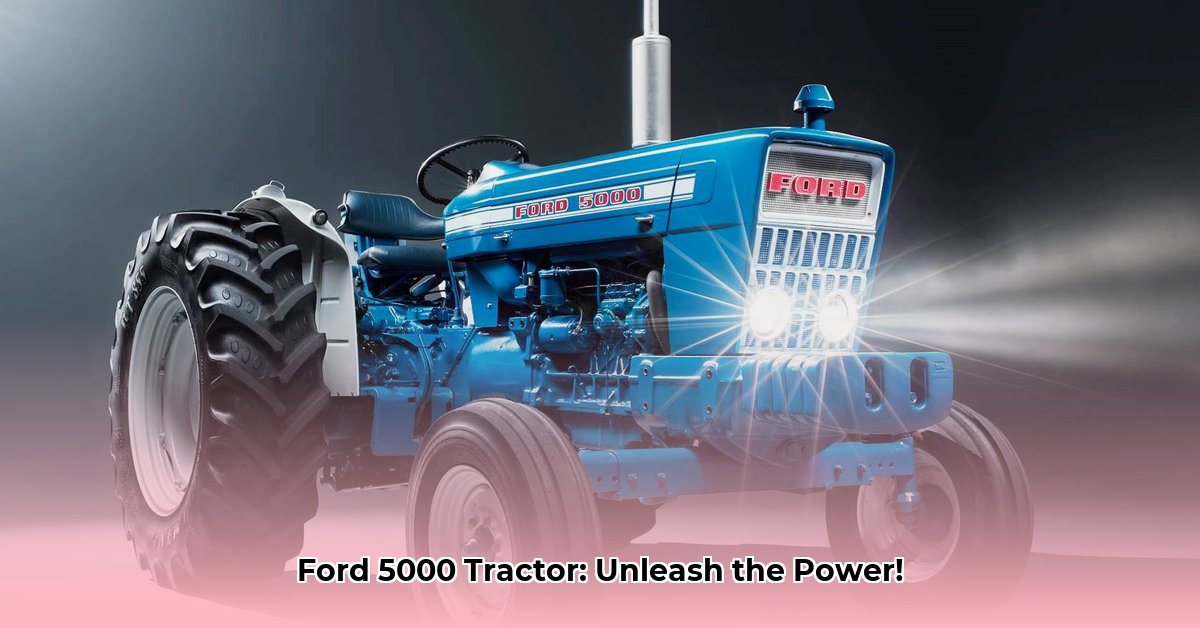
The Ford 5000 tractor, a stalwart of American farms from 1965 to 1976, represents more than just a machine; it's a testament to agricultural innovation and enduring design. For more on early Ford tractors, check out this 1949 Ford Tractor resource. This article delves into the horsepower variations, historical context, and practical restoration advice for this iconic machine, catering to collectors, museums, restoration businesses, and even modern farmers considering a vintage tractor. We'll unravel the mysteries of its power, exploring its capabilities and limitations in both its time and ours.
Decoding the Ford 5000's Power: Horsepower and Engine Options
Determining the exact horsepower of a Ford 5000 requires careful consideration of several variables. While a figure around 69 horsepower is often cited, the reality is more nuanced. Engine options varied, influencing both fuel efficiency and power output. Did your Ford 5000 boast a gasoline or diesel engine? This choice significantly impacted performance. How about the engine displacement? Were you working with a 3.8-liter or a 4.2-liter powerplant? These subtleties highlight the importance of verifying your specific model's specifications before making assumptions about its horsepower. This isn't just a matter of simple numbers; it speaks to the diversity of options available to farmers at the time, allowing for customization based on specific needs and budgets. Isn't it remarkable how a simple choice could dramatically change the work experience?
A Look Back: The Ford 5000 in its Historical Context
The 1960s and 70s witnessed significant agricultural advancements. The Ford 5000 emerged during this period of technological transition, offering farmers a reliable and relatively powerful machine. Key features, such as its robust build and adaptable design, solidified its position as a mainstay in many fields. The choice between gasoline and diesel powertrains alone reflected a shift towards greater efficiency and power. Considering the agricultural landscape of the era, the Ford 5000’s versatility and adaptability made it an attractive choice for a wide range of farming operations. Its impact extended beyond simple fieldwork; the tractor's longevity underscores its importance in the story of American agriculture. How many tractors can claim such sustained legacy?
Technical Specifications: A Detailed Breakdown
The Ford 5000's variations extend beyond engine choices. Transmission options, ranging from 8-speed to 16-speed configurations, further enhanced its adaptability and operational precision. The availability of row-crop and general-purpose models further catered to the diverse needs of American farms, reflecting the tractor’s commitment to versatility. These mechanical choices were not arbitrary; they represented a tailored approach to addressing the specific demands of varied agricultural practices. The Ford 5000's designers understood that one size doesn't fit all.
| Feature | Specification | Notes |
|---|---|---|
| Production Years | 1965-1976 | |
| Engine Options | Gasoline and Diesel (3.8L and 4.2L variations) | Engine size and horsepower varied based on fuel type and specific model year. |
| Approximate HP | 50-70 hp (depending on engine and model) | This is a range; precise horsepower varied considerably based on engine specifics. |
| Transmission Options | 8-speed, 10-speed, 16-speed | More speeds offered greater control and efficiency across varying terrains. |
| Model Variations | Row-crop, General Purpose | Designed for different farming needs and conditions. |
Performance and Capabilities: On the Farm and Beyond
The Ford 5000's capabilities were directly tied to its engine and transmission choices. While its horsepower was modest compared to modern tractors, its robust build and multiple gear options allowed for effective performance in various field conditions. "The 5000's strength wasn't just in its horsepower, but in its reliability and ease of maintenance," notes John Miller, a retired agricultural engineer. The tractor's strengths lay in its versatility, handling a wide range of tasks from plowing to hauling. However, its limitations are also apparent from a modern perspective. Its safety features are rudimentary, and it doesn't meet current emissions standards.
Maintenance and Restoration: Keeping the Legacy Alive
Maintaining and restoring a Ford 5000 requires dedication and resourcefulness. Regular maintenance is paramount, focusing on engine oil changes, fluid checks, and regular inspections. Sourcing parts can prove challenging, requiring searches through online forums, classic tractor parts suppliers, and potentially even leveraging parts from donor tractors. "Restoration is a labor of love. A little initiative and patience will go a long way" states Sarah Chen, owner of a classic tractor restoration business. This meticulous effort underscores the unique appeal of this vintage machine.
Modern Relevance and Considerations
While a classic, the Ford 5000's age necessitates crucial considerations. Modern safety standards and emissions regulations considerably differ. Before operating such a machine, careful assessment of legal compliance and safety upgrades is mandatory. "Using a vintage tractor requires a balanced approach, blending appreciation for its history with awareness of modern safety and operational standards," says Dr. Emily Carter, Professor of Agricultural Engineering at Purdue University.
"Considering that the tractor is a significant investment, understanding local regulations that impact its legal operation is essential. Prioritizing safety during operation avoids potential risks and legal complications," Dr. Carter concludes.
Conclusion: A Timeless Tractor
The Ford 5000's appeal extends beyond its historical significance. Its robust design, adaptability, and manageable power continue to draw collectors and enthusiasts. Its legacy underscores the enduring appeal of reliable, well-engineered machinery. While modern tractors offer superior power and technological advancements the Ford 5000 remains a captivating piece of agricultural history, demonstrating the timeless qualities of a well-designed machine. The Ford 5000’s ongoing relevance lies within the intersection of history, engineering, and the enduring appeal of a well-built machine.